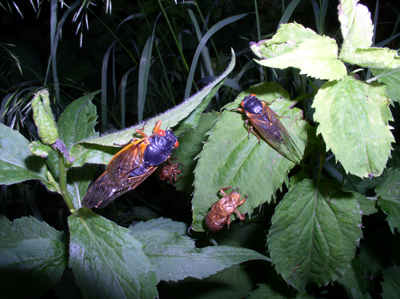Cicadas return to northwest Indiana after 17-year hiatus
Ag Communications
By Jennifer Stewart
May 8, 2007
 |
Cicadas emerging
Photo by: Steve Yaninek |
WEST LAFAYETTE, Ind. - As the soil temperature warms, a new love song will fill the air in northwestern Indiana. After spending the last 17 years underground feeding on tree roots, millions of periodical cicadas - up to 1.5 million per acre - will resurface in Lake, LaPorte and Porter counties to mature, attract mates and lay their eggs.
In late May, the last immature-stage cicadas will begin to crawl out of the ground and latch onto vertical plants, fenceposts or other above-ground structures where they can molt into adults, said Purdue University entomologist Cliff Sadof.
Adults will mate seven to 10 days later and females will lay eggs into slits cut into the twigs of many tree species. In six weeks, these eggs will hatch into nymphs that will fall to the ground and crawl beneath the soil where they will feed on tree roots for the next 17 years.
"Because these insects are only around once every 17 years, this is a good opportunity to appreciate and learn about natural history," Sadof said. "The cicadas don't bite humans and won't kill trees, so they should trigger a curiosity about nature."
Those who are curious can look for periodical cicadas by checking trees that were present 17 years ago and listening for the shrill mating calls that can be heard up to a quarter mile away.
"The cicadas will be most concentrated at forest edges where they will be warmed by sunlight early in the day," Sadof said. "Males need to reach a critical temperature to be able to sing. Early singers out compete their rivals for females.
As adults, their red eyes, 1.5- to 2-inch-long black bodies, orange legs and clear wings help to easily identify periodical cicadas.
When searching for a place to lay eggs, periodical cicadas prefer tree branches 3/16 inch to 7/16 inch in diameter. They will land on any one of more than 200 tree species, including oak, hickory and flowering fruit trees. However, they tend to avoid birch, magnolia or evergreen trees, Sadof said.
The trees at highest risk for potential cicada damage are those with a main stem or trunk less than a half inch wide. These young trees can be protected by caging them or by spraying insecticides.
"These insects fly for six weeks, and during that time pesticides will be most effective when used every three to seven days," Sadof said.
For many people, spraying this often is an impractical task, so Sadof suggests just living with the insect. Because periodical cicadas are so numerous - and noisy - their presence should be kept in mind.
"If you're planning an outdoor event, this is something that should definitely be taken into consideration," he said. "But often times if people have life-changing events when cicadas are present, it is something that serves to remind them every 17 years."
Planning big events around the cicadas isn't the only way to deal with their presence.
"You can eat them," Sadof said. "They are edible, but people who are allergic to shellfish shouldn't eat them."
Humans aren't the only ones who can eat cicadas, however. Birds, fish, spiders and snakes eat periodical cicadas, and sometimes dogs and cats will do the same.
To learn more about periodical cicadas, insecticide use, resistant plants and other cicada broods in Indiana, visit http://www.entm.purdue.edu/entomology/ext/targets/e-series/eseriespdf/e-47.pdf . Information also is available online at http://www.cicadamania.com/cicadas/ or by calling Sadof at (765) 494-5983.
Writer: Jennifer Stewart, (765) 494-6682, jsstewar@purdue.edu
Source: Cliff Sadof, (765) 494-5983, csadof@purdue.edu
|